park assist GMC SIERRA 2004 Owner's Manual
[x] Cancel search | Manufacturer: GMC, Model Year: 2004, Model line: SIERRA, Model: GMC SIERRA 2004Pages: 588, PDF Size: 3.74 MB
Page 157 of 588
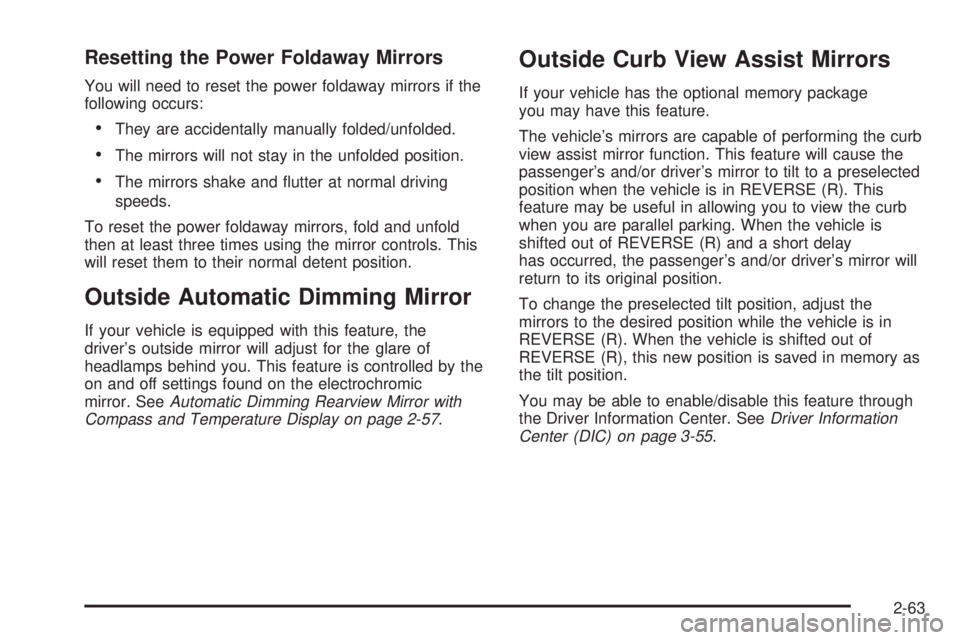
Resetting the Power Foldaway Mirrors
You will need to reset the power foldaway mirrors if the
following occurs:
·They are accidentally manually folded/unfolded.
·The mirrors will not stay in the unfolded position.
·The mirrors shake and ¯utter at normal driving
speeds.
To reset the power foldaway mirrors, fold and unfold
then at least three times using the mirror controls. This
will reset them to their normal detent position.
Outside Automatic Dimming Mirror
If your vehicle is equipped with this feature, the
driver's outside mirror will adjust for the glare of
headlamps behind you. This feature is controlled by the
on and off settings found on the electrochromic
mirror. See
Automatic Dimming Rearview Mirror with
Compass and Temperature Display on page 2-57.
Outside Curb View Assist Mirrors
If your vehicle has the optional memory package
you may have this feature.
The vehicle's mirrors are capable of performing the curb
view assist mirror function. This feature will cause the
passenger's and/or driver's mirror to tilt to a preselected
position when the vehicle is in REVERSE (R). This
feature may be useful in allowing you to view the curb
when you are parallel parking. When the vehicle is
shifted out of REVERSE (R) and a short delay
has occurred, the passenger's and/or driver's mirror will
return to its original position.
To change the preselected tilt position, adjust the
mirrors to the desired position while the vehicle is in
REVERSE (R). When the vehicle is shifted out of
REVERSE (R), this new position is saved in memory as
the tilt position.
You may be able to enable/disable this feature through
the Driver Information Center. See
Driver Information
Center (DIC) on page 3-55.
2-63
Page 169 of 588
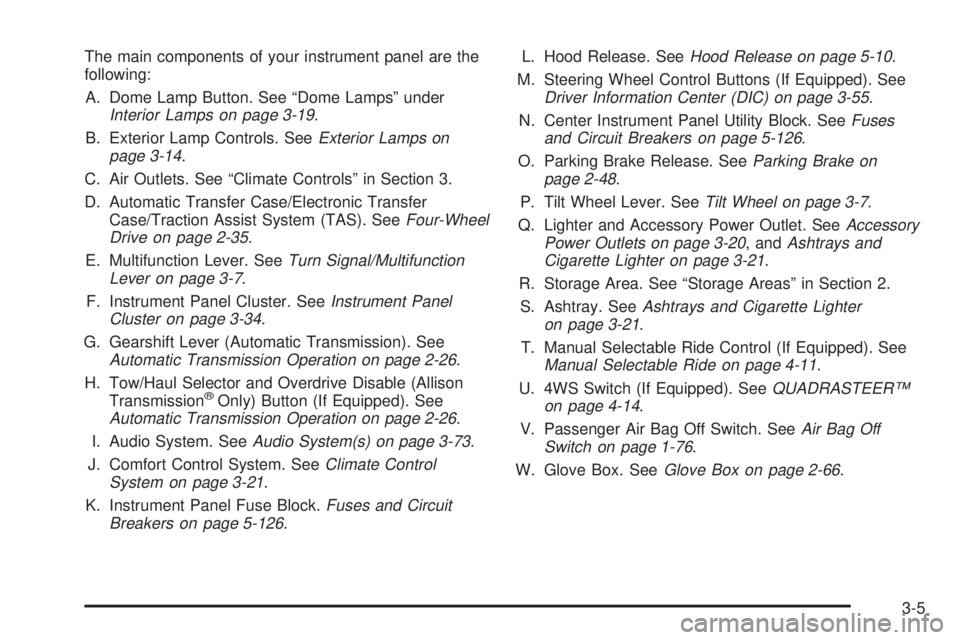
The main components of your instrument panel are the
following:
A. Dome Lamp Button. See ªDome Lampsº under
Interior Lamps on page 3-19.
B. Exterior Lamp Controls. See
Exterior Lamps on
page 3-14.
C. Air Outlets. See ªClimate Controlsº in Section 3.
D. Automatic Transfer Case/Electronic Transfer
Case/Traction Assist System (TAS). See
Four-Wheel
Drive on page 2-35.
E. Multifunction Lever. See
Turn Signal/Multifunction
Lever on page 3-7.
F. Instrument Panel Cluster. See
Instrument Panel
Cluster on page 3-34.
G. Gearshift Lever (Automatic Transmission). See
Automatic Transmission Operation on page 2-26.
H. Tow/Haul Selector and Overdrive Disable (Allison
Transmission
žOnly) Button (If Equipped). SeeAutomatic Transmission Operation on page 2-26.
I. Audio System. See
Audio System(s) on page 3-73.
J. Comfort Control System. See
Climate Control
System on page 3-21.
K. Instrument Panel Fuse Block.
Fuses and Circuit
Breakers on page 5-126.L. Hood Release. See
Hood Release on page 5-10.
M. Steering Wheel Control Buttons (If Equipped). See
Driver Information Center (DIC) on page 3-55.
N. Center Instrument Panel Utility Block. See
Fuses
and Circuit Breakers on page 5-126.
O. Parking Brake Release. See
Parking Brake on
page 2-48.
P. Tilt Wheel Lever. See
Tilt Wheel on page 3-7.
Q. Lighter and Accessory Power Outlet. See
Accessory
Power Outlets on page 3-20, andAshtrays and
Cigarette Lighter on page 3-21.
R. Storage Area. See ªStorage Areasº in Section 2.
S. Ashtray. See
Ashtrays and Cigarette Lighter
on page 3-21.
T. Manual Selectable Ride Control (If Equipped). See
Manual Selectable Ride on page 4-11.
U. 4WS Switch (If Equipped). See
QUADRASTEERŸ
on page 4-14.
V. Passenger Air Bag Off Switch. See
Air Bag Off
Switch on page 1-76.
W. Glove Box. See
Glove Box on page 2-66.
3-5
Page 212 of 588
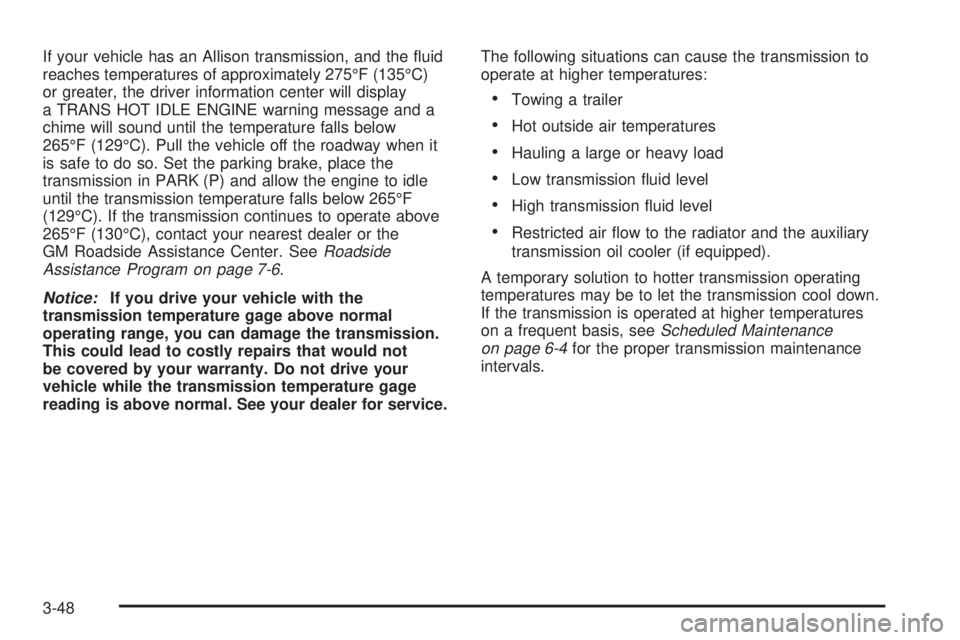
If your vehicle has an Allison transmission, and the ¯uid
reaches temperatures of approximately 275ÉF (135ÉC)
or greater, the driver information center will display
a TRANS HOT IDLE ENGINE warning message and a
chime will sound until the temperature falls below
265ÉF (129ÉC). Pull the vehicle off the roadway when it
is safe to do so. Set the parking brake, place the
transmission in PARK (P) and allow the engine to idle
until the transmission temperature falls below 265ÉF
(129ÉC). If the transmission continues to operate above
265ÉF (130ÉC), contact your nearest dealer or the
GM Roadside Assistance Center. See
Roadside
Assistance Program on page 7-6.
Notice:If you drive your vehicle with the
transmission temperature gage above normal
operating range, you can damage the transmission.
This could lead to costly repairs that would not
be covered by your warranty. Do not drive your
vehicle while the transmission temperature gage
reading is above normal. See your dealer for service.The following situations can cause the transmission to
operate at higher temperatures:
·Towing a trailer
·Hot outside air temperatures
·Hauling a large or heavy load
·Low transmission ¯uid level
·High transmission ¯uid level
·Restricted air ¯ow to the radiator and the auxiliary
transmission oil cooler (if equipped).
A temporary solution to hotter transmission operating
temperatures may be to let the transmission cool down.
If the transmission is operated at higher temperatures
on a frequent basis, see
Scheduled Maintenance
on page 6-4for the proper transmission maintenance
intervals.
3-48
Page 306 of 588
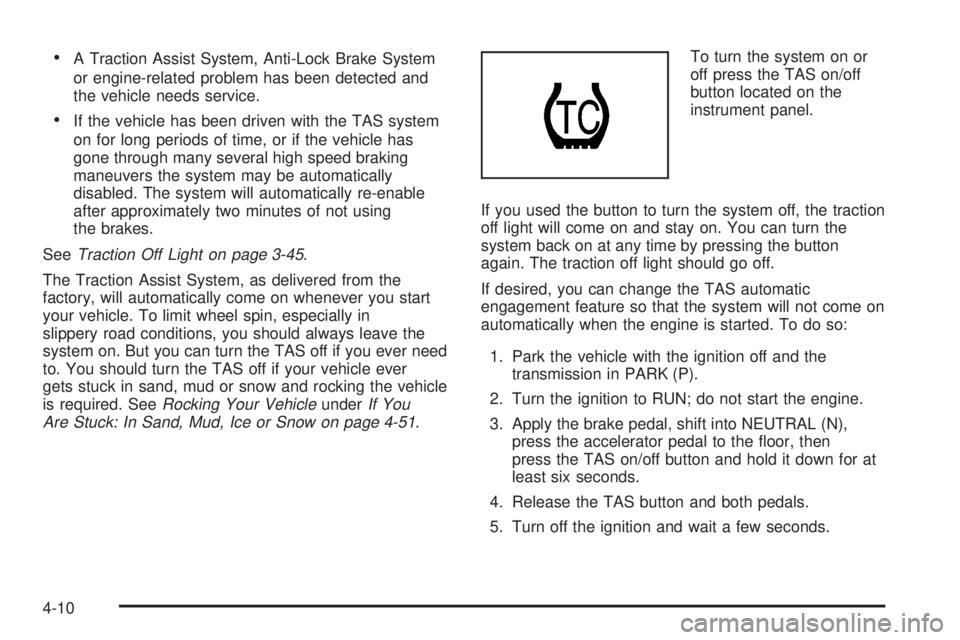
·A Traction Assist System, Anti-Lock Brake System
or engine-related problem has been detected and
the vehicle needs service.
·If the vehicle has been driven with the TAS system
on for long periods of time, or if the vehicle has
gone through many several high speed braking
maneuvers the system may be automatically
disabled. The system will automatically re-enable
after approximately two minutes of not using
the brakes.
See
Traction Off Light on page 3-45.
The Traction Assist System, as delivered from the
factory, will automatically come on whenever you start
your vehicle. To limit wheel spin, especially in
slippery road conditions, you should always leave the
system on. But you can turn the TAS off if you ever need
to. You should turn the TAS off if your vehicle ever
gets stuck in sand, mud or snow and rocking the vehicle
is required. See
Rocking Your VehicleunderIf You
Are Stuck: In Sand, Mud, Ice or Snow on page 4-51.To turn the system on or
off press the TAS on/off
button located on the
instrument panel.
If you used the button to turn the system off, the traction
off light will come on and stay on. You can turn the
system back on at any time by pressing the button
again. The traction off light should go off.
If desired, you can change the TAS automatic
engagement feature so that the system will not come on
automatically when the engine is started. To do so:
1. Park the vehicle with the ignition off and the
transmission in PARK (P).
2. Turn the ignition to RUN; do not start the engine.
3. Apply the brake pedal, shift into NEUTRAL (N),
press the accelerator pedal to the ¯oor, then
press the TAS on/off button and hold it down for at
least six seconds.
4. Release the TAS button and both pedals.
5. Turn off the ignition and wait a few seconds.
4-10
Page 368 of 588
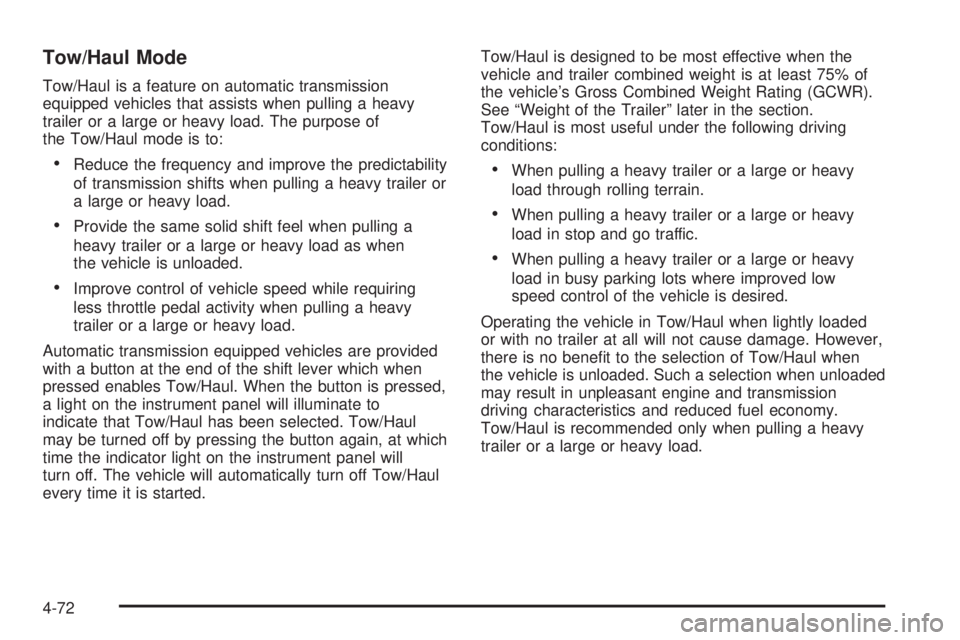
Tow/Haul Mode
Tow/Haul is a feature on automatic transmission
equipped vehicles that assists when pulling a heavy
trailer or a large or heavy load. The purpose of
the Tow/Haul mode is to:
·Reduce the frequency and improve the predictability
of transmission shifts when pulling a heavy trailer or
a large or heavy load.
·Provide the same solid shift feel when pulling a
heavy trailer or a large or heavy load as when
the vehicle is unloaded.
·Improve control of vehicle speed while requiring
less throttle pedal activity when pulling a heavy
trailer or a large or heavy load.
Automatic transmission equipped vehicles are provided
with a button at the end of the shift lever which when
pressed enables Tow/Haul. When the button is pressed,
a light on the instrument panel will illuminate to
indicate that Tow/Haul has been selected. Tow/Haul
may be turned off by pressing the button again, at which
time the indicator light on the instrument panel will
turn off. The vehicle will automatically turn off Tow/Haul
every time it is started.Tow/Haul is designed to be most effective when the
vehicle and trailer combined weight is at least 75% of
the vehicle's Gross Combined Weight Rating (GCWR).
See ªWeight of the Trailerº later in the section.
Tow/Haul is most useful under the following driving
conditions:
·When pulling a heavy trailer or a large or heavy
load through rolling terrain.
·When pulling a heavy trailer or a large or heavy
load in stop and go traffic.
·When pulling a heavy trailer or a large or heavy
load in busy parking lots where improved low
speed control of the vehicle is desired.
Operating the vehicle in Tow/Haul when lightly loaded
or with no trailer at all will not cause damage. However,
there is no bene®t to the selection of Tow/Haul when
the vehicle is unloaded. Such a selection when unloaded
may result in unpleasant engine and transmission
driving characteristics and reduced fuel economy.
Tow/Haul is recommended only when pulling a heavy
trailer or a large or heavy load.
4-72
Page 567 of 588
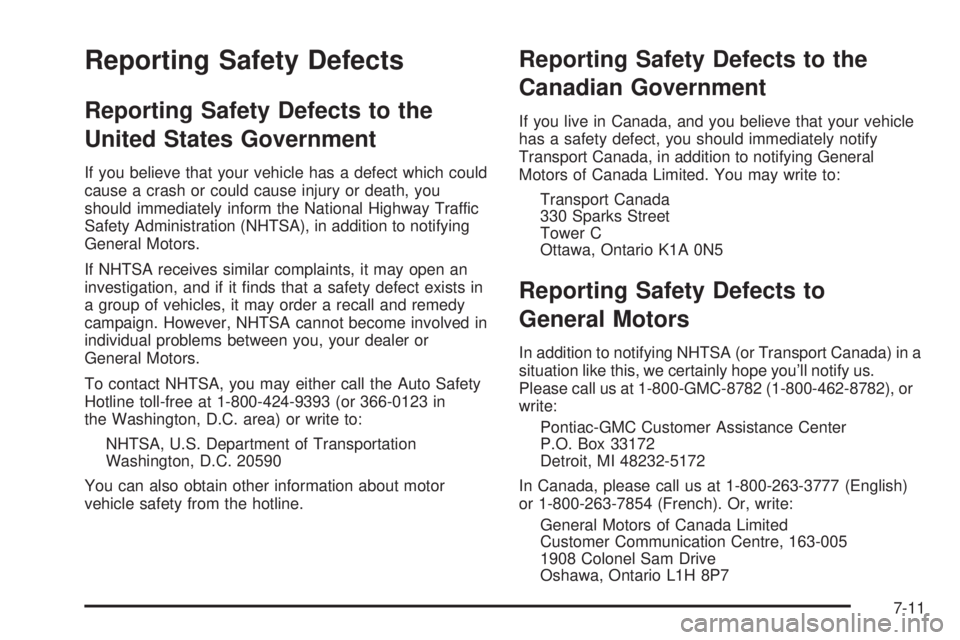
Reporting Safety Defects
Reporting Safety Defects to the
United States Government
If you believe that your vehicle has a defect which could
cause a crash or could cause injury or death, you
should immediately inform the National Highway Traffic
Safety Administration (NHTSA), in addition to notifying
General Motors.
If NHTSA receives similar complaints, it may open an
investigation, and if it ®nds that a safety defect exists in
a group of vehicles, it may order a recall and remedy
campaign. However, NHTSA cannot become involved in
individual problems between you, your dealer or
General Motors.
To contact NHTSA, you may either call the Auto Safety
Hotline toll-free at 1-800-424-9393 (or 366-0123 in
the Washington, D.C. area) or write to:
NHTSA, U.S. Department of Transportation
Washington, D.C. 20590
You can also obtain other information about motor
vehicle safety from the hotline.
Reporting Safety Defects to the
Canadian Government
If you live in Canada, and you believe that your vehicle
has a safety defect, you should immediately notify
Transport Canada, in addition to notifying General
Motors of Canada Limited. You may write to:
Transport Canada
330 Sparks Street
Tower C
Ottawa, Ontario K1A 0N5
Reporting Safety Defects to
General Motors
In addition to notifying NHTSA (or Transport Canada) in a
situation like this, we certainly hope you'll notify us.
Please call us at 1-800-GMC-8782 (1-800-462-8782), or
write:
Pontiac-GMC Customer Assistance Center
P.O. Box 33172
Detroit, MI 48232-5172
In Canada, please call us at 1-800-263-3777 (English)
or 1-800-263-7854 (French). Or, write:
General Motors of Canada Limited
Customer Communication Centre, 163-005
1908 Colonel Sam Drive
Oshawa, Ontario L1H 8P7
7-11
Page 581 of 588
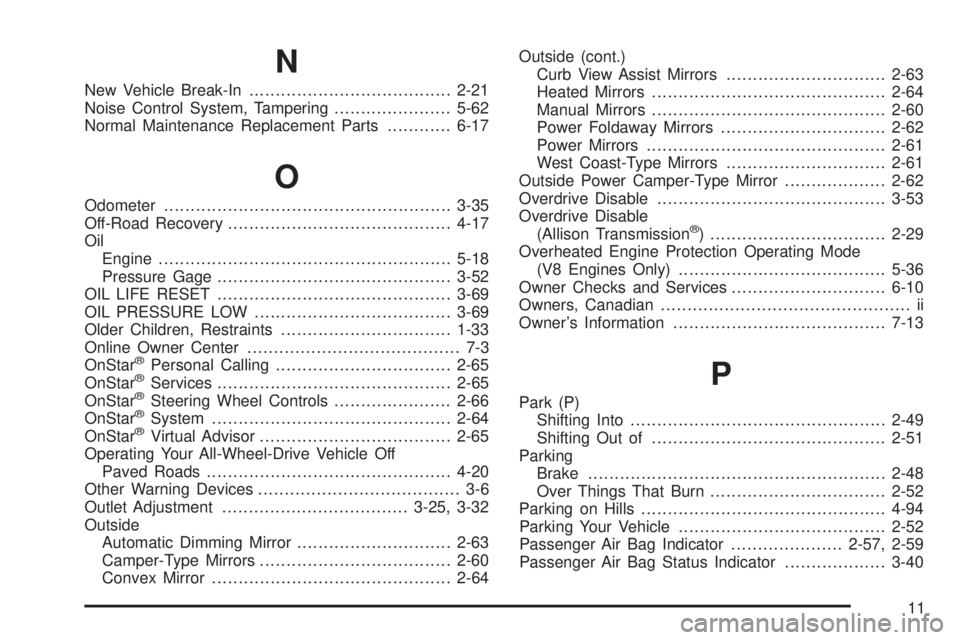
N
New Vehicle Break-In......................................2-21
Noise Control System, Tampering......................5-62
Normal Maintenance Replacement Parts............6-17
O
Odometer......................................................3-35
Off-Road Recovery..........................................4-17
Oil
Engine.......................................................5-18
Pressure Gage............................................3-52
OIL LIFE RESET............................................3-69
OIL PRESSURE LOW.....................................3-69
Older Children, Restraints................................1-33
Online Owner Center........................................ 7-3
OnStar
žPersonal Calling.................................2-65
OnStaržServices............................................2-65
OnStaržSteering Wheel Controls......................2-66
OnStaržSystem.............................................2-64
OnStaržVirtual Advisor....................................2-65
Operating Your All-Wheel-Drive Vehicle Off
Paved Roads..............................................4-20
Other Warning Devices...................................... 3-6
Outlet Adjustment...................................3-25, 3-32
Outside
Automatic Dimming Mirror.............................2-63
Camper-Type Mirrors....................................2-60
Convex Mirror.............................................2-64Outside (cont.)
Curb View Assist Mirrors..............................2-63
Heated Mirrors............................................2-64
Manual Mirrors............................................2-60
Power Foldaway Mirrors...............................2-62
Power Mirrors.............................................2-61
West Coast-Type Mirrors..............................2-61
Outside Power Camper-Type Mirror...................2-62
Overdrive Disable...........................................3-53
Overdrive Disable
(Allison Transmission
ž) .................................2-29
Overheated Engine Protection Operating Mode
(V8 Engines Only).......................................5-36
Owner Checks and Services.............................6-10
Owners, Canadian............................................... ii
Owner's Information........................................7-13
P
Park (P)
Shifting Into................................................2-49
Shifting Out of............................................2-51
Parking
Brake........................................................2-48
Over Things That Burn.................................2-52
Parking on Hills..............................................4-94
Parking Your Vehicle.......................................2-52
Passenger Air Bag Indicator.....................2-57, 2-59
Passenger Air Bag Status Indicator...................3-40
11
Page 583 of 588
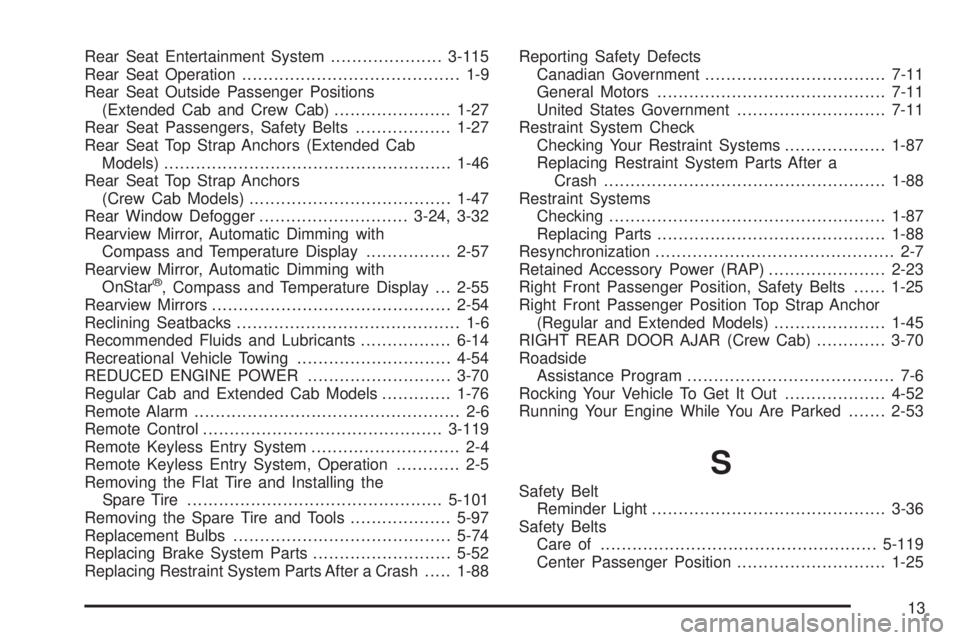
Rear Seat Entertainment System.....................3-115
Rear Seat Operation......................................... 1-9
Rear Seat Outside Passenger Positions
(Extended Cab and Crew Cab)......................1-27
Rear Seat Passengers, Safety Belts..................1-27
Rear Seat Top Strap Anchors (Extended Cab
Models)......................................................1-46
Rear Seat Top Strap Anchors
(Crew Cab Models)......................................1-47
Rear Window Defogger............................3-24, 3-32
Rearview Mirror, Automatic Dimming with
Compass and Temperature Display................2-57
Rearview Mirror, Automatic Dimming with
OnStar
ž, Compass and Temperature Display . . . 2-55
Rearview Mirrors.............................................2-54
Reclining Seatbacks.......................................... 1-6
Recommended Fluids and Lubricants.................6-14
Recreational Vehicle Towing.............................4-54
REDUCED ENGINE POWER...........................3-70
Regular Cab and Extended Cab Models.............1-76
Remote Alarm.................................................. 2-6
Remote Control.............................................3-119
Remote Keyless Entry System............................ 2-4
Remote Keyless Entry System, Operation............ 2-5
Removing the Flat Tire and Installing the
Spare Tire................................................5-101
Removing the Spare Tire and Tools...................5-97
Replacement Bulbs.........................................5-74
Replacing Brake System Parts..........................5-52
Replacing Restraint System Parts After a Crash.....1-88Reporting Safety Defects
Canadian Government..................................7-11
General Motors...........................................7-11
United States Government............................7-11
Restraint System Check
Checking Your Restraint Systems...................1-87
Replacing Restraint System Parts After a
Crash.....................................................1-88
Restraint Systems
Checking....................................................1-87
Replacing Parts...........................................1-88
Resynchronization............................................. 2-7
Retained Accessory Power (RAP)......................2-23
Right Front Passenger Position, Safety Belts......1-25
Right Front Passenger Position Top Strap Anchor
(Regular and Extended Models).....................1-45
RIGHT REAR DOOR AJAR (Crew Cab).............3-70
Roadside
Assistance Program....................................... 7-6
Rocking Your Vehicle To Get It Out...................4-52
Running Your Engine While You Are Parked.......2-53
S
Safety Belt
Reminder Light............................................3-36
Safety Belts
Care of....................................................5-119
Center Passenger Position............................1-25
13